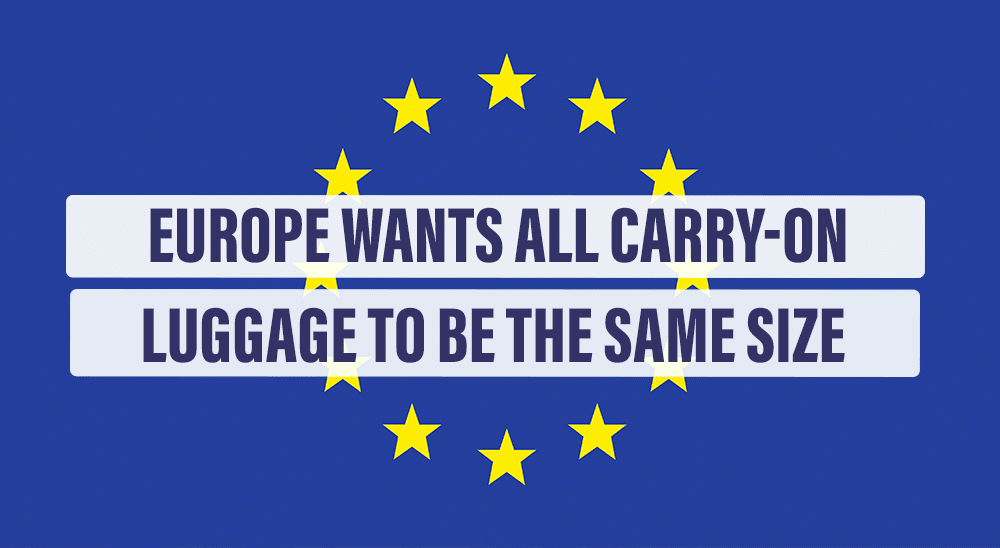When we are in an airport, we can usually see small metal bars shaped like suitcases. These frames are used to indicate the optimal size of carry-on luggage that passengers can bring.
The problem is that each airline has a different frame. Even if your carry-on fits in the frame of airline “A,” it might not fit in the frame of airline “B.”
This has led to chaos internationally, as many people try new airlines only to find that their suitcase can no longer be carried in the cabin because it exceeds the maximum dimensions.
To mitigate the avalanche of complaints and problems that this has generated, the European Union has decided to take action on the matter. In this article, we will delve deeper into the issue and explore how the EU might find a solution that benefits the continent’s largest airlines.
Let’s dive in!
Airlines Want to Decide for Themselves
The issue mentioned in the introduction affects not only the dimensions of luggage but also the additional fees charged for it. A passenger no longer knows what size suitcase they can carry and how much they have to pay to bring it since all airlines are different.
To reach a common solution, various organizations across Europe, including the European Commission, the European Parliament, and the Airline Association (ALA), have come together.
Even after negotiations, airlines argue that their fees are guaranteed by Regulation EC 1008/2008, which establishes complete pricing freedom in the transport sector.
However, the European Parliament has based its request on a 2014 ruling from the EU Court of Justice, which states that carry-on luggage should be considered an “indispensable element of passenger transport,” requiring that its transport should not be subject to an additional charge.
But does this measure really apply, or can airlines charge passengers for carrying carry-on luggage?

Are There Fees for Carry-On Luggage?
Recently, the Spanish Ministry of Consumer Affairs (supported by the Organization of Consumers and Users) launched an investigation against several companies that were charging for carry-on luggage.
According to aviation law, the transport of the traveler and their luggage must be included in the ticket price free of charge.
However, this rule begins to break down when it comes to weight and volume limits set by each airline, as some companies claim that larger-than-normal luggage requires additional fees.
This can be unfair to many people, as some maximum dimensions set by certain airlines are clearly insufficient for passengers’ needs. To fight for these people’s rights, the International Air Transport Association (IATA) consulted with aircraft manufacturers Boeing and Airbus about the most recommended dimensions for carry-on luggage.
Based on this consultation, they issued an “official” recommendation suggesting not to exceed 55x35x20 cm, including wheels, handles, and pockets. Although IATA proposes these measurements, there is no standard accepted by all airlines, leading to confusion and frustration among passengers.
For example, some airlines like Ryanair and Wizz Air have the smallest carry-on luggage sizes. On the other hand, Easyjet, Iberia, and Vueling have larger dimensions. This lack of uniformity creates delicate situations, as luggage from one airline may not be accepted by another.
The EU Calls for an Agreement Among Airlines
In this context, the European Commissioner for Transport has asked companies to reach an amicable agreement on suitcase sizes.
The goal is to finally unify the dimensions of carry-on luggage, thus avoiding the complications travelers face when trying to comply with different regulations.
The big problem is that the resolution adopted by Parliament is not legally binding, as this EU body can make recommendations but cannot issue judgments or enforce its measures.
Therefore, the Airline Association emphasized that Parliament’s resolution is not binding and that airlines are not required to change their luggage policies, so they will not do so.
Airlines argue that charging for cabin luggage is legal and that they only seek to give consumers the option to choose. They point out that some passengers travel without carry-on luggage, which represents up to 40% of their customers, who would be underserved if they had to pay the same price to carry a suitcase as those who do not.
In short, the issue of carry-on luggage on European airlines requires a review and possibly a unification of rules and fees. A lack of consistency in luggage policies creates inconvenience for travelers and hinders price comparison among options.
Even so, since the judgments of these bodies are not binding, we will likely not see a unification of prices and measurements in the near future, at least until a court intervenes with enforceable rulings.

